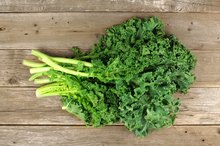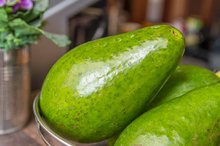What does fact checked mean?
At Healthfully, we strive to deliver objective content that is accurate and up-to-date. Our team periodically reviews articles in order to ensure content quality. The sources cited below consist of evidence from peer-reviewed journals, prominent medical organizations, academic associations, and government data.
The information contained on this site is for informational purposes only, and should not be used as a substitute for the advice of a professional health care provider. Please check with the appropriate physician regarding health questions and concerns. Although we strive to deliver accurate and up-to-date information, no guarantee to that effect is made.
Nutritional Value of Food Groups
Some foods contain many of the same nutrients as others, and when this is the case, these foods are usually grouped together. Some dietary guidelines group foods differently. For example, meat and fish may be put in one food group and nuts, seeds and beans in another. All of these foods are protein foods, and they have many of the same nutrients. Knowing the nutritional value of foods in these food groups and incorporating nutritious foods from each food group in your diet may help you remain in good health.
Types
The U.S. Department of Agriculture offers a food guidance system that puts foods into six food groups. The first food group is the grains group, which includes grains that are whole and grains that are refined. The second food group lists all vegetables. The third group lists fruits and fruit juices. The fourth lists all of your fats and oils. The fifth lists dairy, and the sixth lists protein foods.
- The U.S. Department of Agriculture offers a food guidance system that puts foods into six food groups.
- The third group lists fruits and fruit juices.
Grains
Vitamins & Minerals That Work Together
Learn More
Grains (especially whole grains) supply the body with fiber that may offer protection against heart disease, constipation and diverticulosis. Folate is known to be a protector against birth defects. Iron, magnesium and selenium are also found in grains. Iron is responsible for oxygen transportation through the blood. Magnesium builds bones, and selenium supports immunity.
- Grains (especially whole grains) supply the body with fiber that may offer protection against heart disease, constipation and diverticulosis.
- Folate is known to be a protector against birth defects.
Vegetables
Vegetables have a cholesterol content of zero. Some vegetables--such as:
- potatoes
- white beans
- soybeans
- spinach
- lentils
- kidney beans--contain potassium
- which can keep blood pressure normal
The absorption of iron is enhanced through the intake of vitamin C, and vitamin C also assists in oral health and wound healing.
Fruits
Foods and Vitamins to Help Heal Nerve Endings
Learn More
Almost all fruits have a low sodium and low fat content, and no fruits contain cholesterol. Fruits are plentiful in nutrients. Some of the nutrients in fruit are potassium, fiber, vitamin C and folate.
Fats and Oils
Fats and oils contain saturated fatty acids and unsaturated fatty acids. Fats that are not liquid have a higher saturated fat content than oils do, and some may contain trans fats. Saturated fats and trans fats have been known to cause heart disease. Oils are higher in monounsaturated fats (MUFAs) and polyunsaturated fats (PUFAs). MUFAs and PUFAs contain vitamin E, and they do not have an adverse effect on heart health. Some of the fatty acids found in polyunsaturated fats are required for good health and are recommended for consumption, but as with all fats and oils, PUFAs are high in calories (roughly 120 a tablespoon) and should be consumed in moderation.
- Fats and oils contain saturated fatty acids and unsaturated fatty acids.
- Fats that are not liquid have a higher saturated fat content than oils do, and some may contain trans fats.
Dairy Foods
Dairy foods contain calcium, which is necessary for healthy bones. Foods in this food group, such as milk and yogurt, are also high in potassium. Some dairy foods are fortified with vitamin D, which is also necessary for bone health. Consumption of whole milk foods may have health consequences when consumed as these foods contain saturated fats and cholesterol that are bad for the heart. Fat-free or low-fat foods from this group are healthier choices.
- Dairy foods contain calcium, which is necessary for healthy bones.
- Some dairy foods are fortified with vitamin D, which is also necessary for bone health.
Meat, Fish, Beans, Nuts and Seeds
Foods from this food group are a good source of protein, which is necessary for the formation of bones, muscles, blood and other body tissues. Enzymes, hormones and vitamins are also supported by protein. A normal immune system may be attained with the intake of zinc 1. Salmon, trout and herring are good sources of PUFAs. Flax and walnuts are sources of essential fatty acids. Rich sources of vitamin E are sunflower seeds, almonds and hazelnuts.
- Foods from this food group are a good source of protein, which is necessary for the formation of bones, muscles, blood and other body tissues.
- Enzymes, hormones and vitamins are also supported by protein.
Related Articles
References
- Omega-3 National Institutes of Health Office of Dietary Supplements. November 21, 2018
- American Heart Association. Polyunsaturated Fat. https://www.heart.org/en/healthy-living/healthy-eating/eat-smart/fats/polyunsaturated-fats
- American Heart Association. Saturated Fat. https://www.heart.org/en/healthy-living/healthy-eating/eat-smart/fats/saturated-fats
- Medline Plus. Facts About Polyunsaturated Fats. https://medlineplus.gov/ency/patientinstructions/000747.htm
- Patterson E, et al. Health implications of high dietary omega-6 polyunsaturated Fatty acids. J Nutr Metab. 2012;2012:539426. doi: 10.1155/2012/539426.
Writer Bio
Based in New York, Grace Covelli has been writing since 1996. Her work has appeared on various websites, many of them health-related. Covelli completed a course in writing for children and teenagers and received a diploma for natural health consulting with highest honors. She also studied reflexology, Reiki and esthetics. One of her hobbies is sewing.









